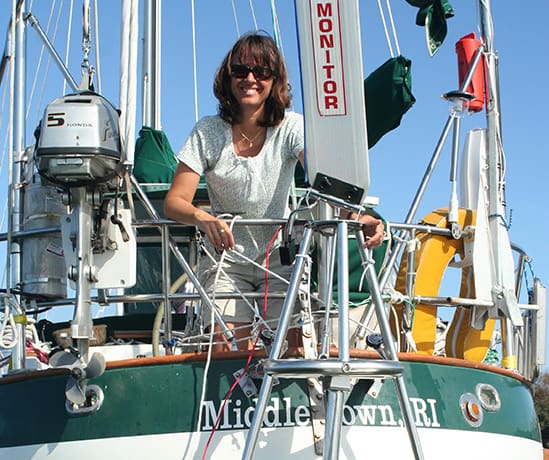
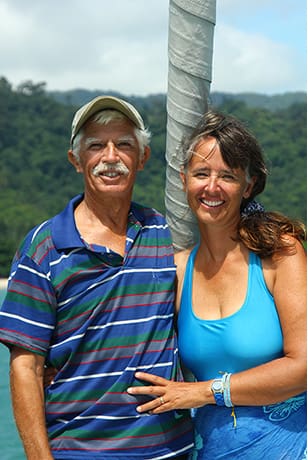

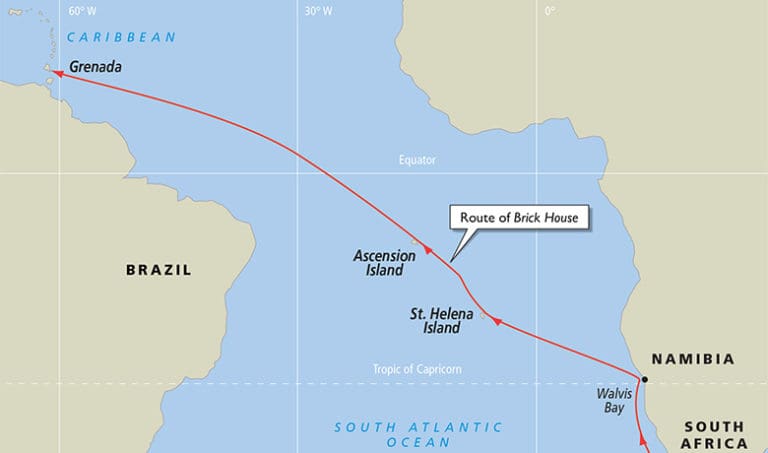
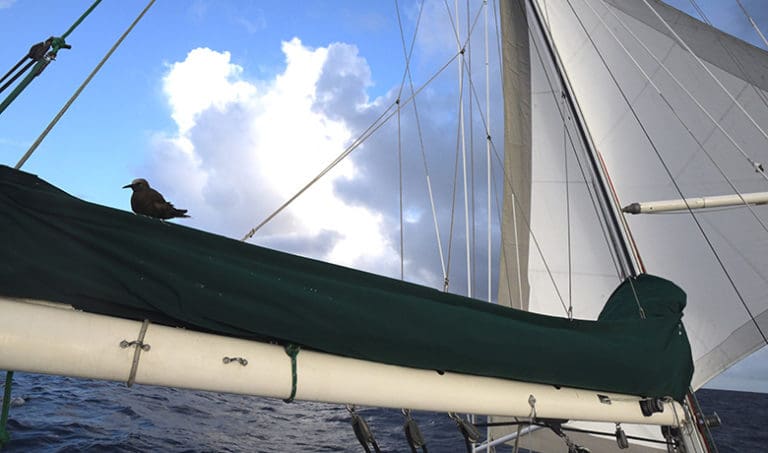
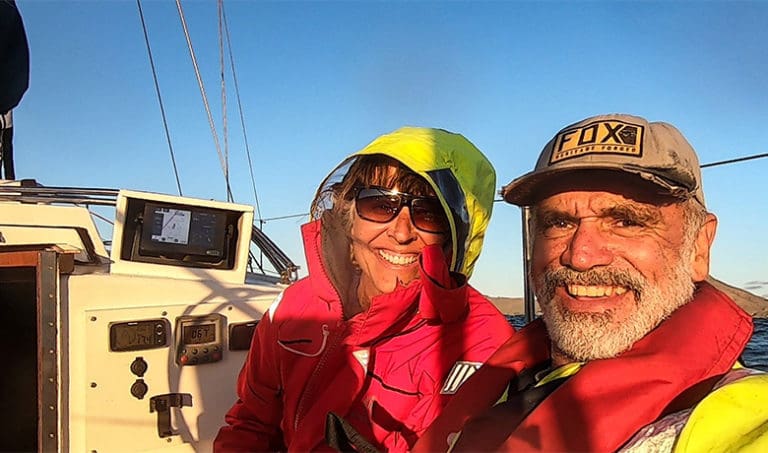
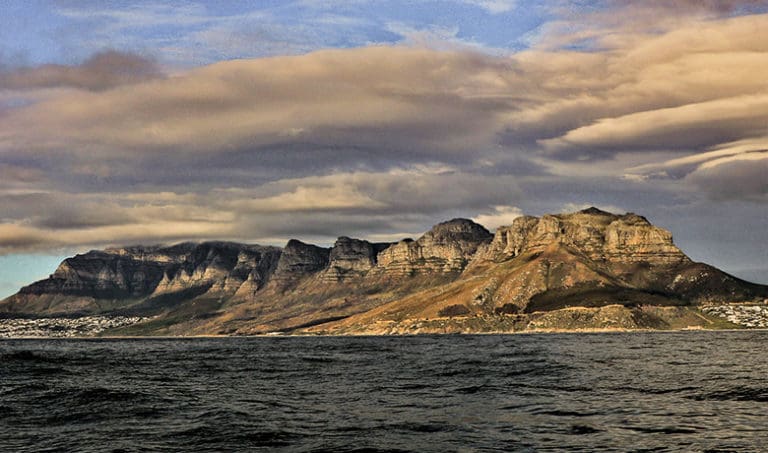
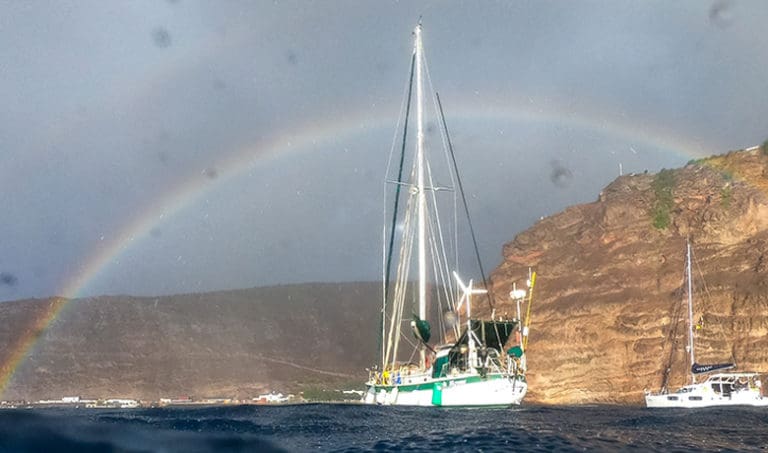
Last year, my husband and captain of 17-plus years passed away from COVID-19, in South Africa. He cared greatly for our Valiant 40, Brick House, and left it in top shape. We were days away from leaving, fully provisioned, for a transatlantic crossing to Uruguay and on to Patagonia. We both came down with COVID-19 and 21 days later Patrick succumbed to it in South Africa. After nearly seven months at a dock while I recovered from the trauma, I chose a captain to accompany me and got ready for a crossing of the South Atlantic from Cape Town to the Caribbean.
As the new captain finished up his land life, I asked myself plenty of questions: was Brick House still ready for an ocean crossing? With a new captain and/or crew, this was a different ballgame than crossing with Patrick’s expertise.
This challenge was about what I could do to make the boat safer and simpler for a captain or crew unfamiliar with the intricacies of Brick House, to keep the people and this old boat safe for my longest passage on any ocean, in any boat, 6,100 miles across the Atlantic Ocean from South Africa to the Caribbean.
Planning The plan was to leave Cape Town in late January, the best time to make the crossing, safest and with the best winds. We would take one additional crew, sailing the notoriously stormy and foggy coast to Walvis Bay, Namibia. We would then sail to Ascension Island with a possible stop in St Helena if it was not closed due to COVID. After that, it really would depend on how the boat and relationship was holding up… and the status of COVID as we approached landfall. The ultimate destination was somewhere between the east coast of the USA and the southern islands of the Caribbean.
Despite my more than 20 years of experience sailing on Brick House, I needed a captain to get safely across an ocean. It wasn’t a trip I wanted to do on my own. Too much can go wrong and it would be difficult to complete with a gear failure, not to mention sailing on my own for such a distance. Plus, who would share the sunsets and fun times with me? There would likely be no better captain than Patrick so I had to do everything possible to compensate for lack of experience and familiarity with Brick House by future crews/captains. I interviewed many potential captains and ultimately chose Michael Hayward, a South African licensed captain. He didn’t have an abundance of ocean crossing experience, but he did have plenty of heavy weather sailing around the notorious capes of South Africa on his own boat and others.
Patrick was a strong-willed, old-fashioned sailor. He wanted things his way, and didn’t spend money on things he didn’t believe in. A new life raft was one of those things. He always had a saying, “you don’t go to sea to sink.” Well, as perhaps a less experienced, more nervous sailor, I was always very unhappy with this order from the captain. Over the years, through personal experiences with people I knew and respect, I had come to realize just how vulnerable we are at sea. New or old boat, experienced or inexperienced, things do fail, and boats do sink! With a new captain in my future, I wanted to make the boat more ready for the worst that can happen. I did my research and bought a new life raft locally. It was usually me that researched and decided on equipment anyway, so this was not a new endeavor. I purchased a Viking life raft from a local company. I felt much better with it than with our old 32-year-old life raft that came with Brick House when I purchased the boat.
Years ago, I had made an executive decision to buy two personal AIS beacons to put on our life vests. As many of you know, Patrick rebelled against life jackets and harnesses — for good personal reasons I suppose, but this always bothered me. A personal AIS unit resides inside a life vest, so if he didn’t wear the life vest then the personal AIS beacon would be of little use. So, I had my life vests serviced and obtained two new personal AIS transponders called MOBLink from ACR. I had just replaced the batteries and serviced my multiple EPIRBS and PLBs onboard… so I just stuck with the company most proven: ACR. Now I’d just have to make sure that the life jackets were worn!
Preparation I knew things would break on Brick House and that many repairs would fall to me. Patrick had a natural talent to repair things, but I am a person who needs solid clues from manuals. I suspected my crew or captain would too. I downloaded every last thing on our boat to give us some chance of repairing underway or in a remote port. I installed all the PDFs on my iPad. I wish I had a printout of every manual like I used to, but space is at a premium on a moderate sailboat like Brick House. When I’m seasick though, finding instructions on my iPad actually proves difficult; my thinking becomes impaired. I should also not be the only one who has access to instructions. But alas, I didn’t find a way around this.
Crewmembers who are unfamiliar with a boat don’t know how gear should operate, what battery readings are normal, how or even what to keep turned off or on. You can hold orientations, but there is no way people are likely to remember everything. So, I resorted to hanging signs all over the boat. Things like “Switch off the wind generator when wind is more than 25 knots or engine on”; or “Keep this port closed no matter what”; or “Switch the pressure water off when done using”; or “Wake up Rebecca if….” I labeled where snacks could be found, where tools were located, etc. I had inventory lists of what parts were in each closet, and a book at the chart table as to where to find things. I had a checklist of things to do and notice while on watch, and exactly how to call a mayday or activate the help function on the Iridium Go, if necessary.
I have these terrible recurring nightmares of Patrick hanging on to our mainsail while it falls all over the deck, trying to raise it or put it away, with reefing lines threatening to rip off the solar panels as well as our heads, and the boat rolling side to side. I didn’t want to see myself or future crew suffering through this scary and chaotic procedure. So, I had a local sailmaker in Cape Town construct a stackpack with lazy jacks. I demanded more cloth where I’ve often, on other boats, seen too little material to protect the front and back of the sail. While stowed I wanted there to be no chance of any sail exposed even if we did a less than stellar job stowing it. The lazy jacks and the built-in cover/sail bag for the mainsail would make both dropping and reefing the sail easier and safer for all involved.
There are many stories of sailors at sea that have one seemingly minor failure, quickly leading to more complicated issues. Often the first failure is the autopilot, forcing everyone to steer. This quickly tires out the crew, leaving them unable to deal with the next breakage. Things then quickly snowball downhill, and people get hurt, boats get broken, and a bad situation gets worse.
We have a Monitor wind vane that, once we mastered it, was to do most of the steering. But our Raymarine autopilot was our backup, our plan B, and our primary steering when we are close to coasts and can’t allow the self-steering vane to potentially follow a wind shift toward land. I needed to know that plan B was a strong one, since I was not sure of my skills setting the wind vane properly. That went for many things onboard; I didn’t know what I didn’t know, things that may be vital for a 6,100-mile ocean passage.
The old autopilot was working fine, though occasionally a bit reluctantly. I ordered a new Raymarine Evolution autopilot to have in storage, along with all the wiring I would need to be sure I wouldn’t be without an autopilot. Yes, it would be hard to install at sea. But at least I’d have the option available. I didn’t want to simply install the new one, because of course a new installation is also prone to failure in the first 50 hours or so. If it ain’t broke, don’t fix it, right? And it wasn’t broke. So I made sure all connections were tight on the existing unit, since loose or corroded connections are often what makes electronics go wacky. Wonderfully, it worked without a problem whenever we needed it, all the way across the Atlantic. I think we have gotten our money out of that autopilot, having originally installed it in 2006 just before the start of our circumnavigation. Thank you Raymarine!
A device that I’ve become quite dependent on while on passages is my Iridium GO. Historically, I’ve employed my SSB to get weather and email, but I find the Iridium GO much easier to use. No more waiting for the perfect propagation time or listening to what other cruisers had for breakfast. But again and again I also heard of Iridium GOs failing. I often wondered if it was human error or are these little robust units really that undependable? Years ago when I heard of problems, I felt like the operator must be doing something wrong. Now I know all things happen to all cruisers. It not if, it’s when. We all get our turn. Crossing an ocean with probably less experienced crew/captain necessitated having reliable communications and reliable weather reports so we could be proactive in sail plans and weather routing to avoid problems. I’ve become quite reliant on Predictwind, and my Iridium GO!
So, to have a plan B in the event my GO bit the dust halfway across, I purchased a second GO. I upgraded its firmware and prepared it for service before leaving the dock. The flaw in my plan, I realized months later, was that the most vulnerable part of the setup is the fragile little connector cable that connects to the external antenna. It hasn’t broken yet, but it will someday. Note to self to order another. Also, if the robust marine antenna from Predictwind were to break, reception is vastly decreased on these units. But I didn’t want to carry a spare antenna as the wiring is thick and bulky. If I had to, I could take the unit outside in good weather to make my connections, so I didn’t purchase a second antenna and wiring. Predictwind was installed on my laptop and on the Raymarine Axiom Pro chartplotter. I have unlimited data on the GO, so the more of us looking at weather, the more likely we are to pick up issues and share ideas.
I replaced all halyards and sheets, as well as standing rigging except the forestay and backstay as those were only three years old. This was all perhaps a little early, but I didn’t need any fire alarms on this passage. Too soon is better than too late. Just before we left Cape Town, we did a rigging check and found the new rigging had a few missing cotter pins. If not for this check and for repeated inspections at every anchorage along the route, we may have lost the mast days after leaving Cape Town. New isn’t always better unless you check the professionals’ work yourself! All work, even by renowned pros, should still be checked by the owner or captain to verify all is well before a long passage.
Michael came on with plenty of ideas of his own on how to improve the safety on Brick House. He felt the handholds on the hard dodger were unreliable, and after some days of repairing the rotted areas, he built an entirely new one. He installed running boards to strap the water and fuel jerry cans to so that nothing would come loose or be in the way moving up and down the deck. He removed flammables in the engine room and designed more secure stowage there. He also was more particular about the food in our ditch bag. Twenty-year-old army rations were not nourishing enough for a life raft he argued. He wanted nuts, cranberries and high-quality nutrition bars. Can’t argue with not dying of mold poisoning in the event of abandoning ship. In addition to the very frequent rigging checks aloft, Michael also insisted on regular diving on the hull to make thorough inspections for cracks and other failures and cleaning off marine growth to be sure of full maneuverability.
Outcome Sailing on Brick House without my familiar captain was a daunting prospect the entire way, both in regard to sailing and my general disposition and comfort level. I didn’t know what the new captain and part time crew would know and not know, nor how safe they’d be. Patrick always felt less experienced crews would generally bring back boats with multiple breakages. Luckily, Michael turned out to be a very competent and able captain. He was safety conscious and placed plenty of emphasis on keeping us both well-nutritioned and hydrated during the long passage. No alcohol was consumed so we would always be well prepared and aware in any emergency.
We arrived with no damage to the boat short of a few chafed patches on the Genoa sun cover, and a loose latch on the wind vane. We fixed the freezer while underway with help from expert Google friends via the GO, as well as the manual. My original Iridium GO flaked out a bit but so did the second one. It turned out to be a fuel tank we tied down on deck immediately above the GO’s GPS antenna.
We wore our life jackets religiously and thankfully nobody fell overboard. Our Predictwind weather reports routed us around adverse currents and through helping currents, predicting squalls with high accuracy. Our Raymarine instruments/Navionics charts were spot on without flaw. The lazy jacks proved more problematic when raising the mainsail, but better when lowering it. Since raising the mainsail is generally in favorable weather and lowering is usually in bad weather or at the end of a tiring sail, I consider it an improvement. Lines, sails and people aren’t flying everywhere during the process. The jerry cans remained in place and moving up and down the deck was easy. The signs reminded us what to do and what not to do. So, overall the trip was a boring, fairly uneventful one. Sometimes, being a bit more nervous and safety conscious, even a bit pessimistic and having the right equipment onboard to back that up, is precisely what’s needed to make sure you get across an ocean.
There was plenty of excitement on the leg from Cape Town to Namibia. A threatening storm cropped up halfway there with 45 plus knot winds. I had only seen that much wind twice in my circumnavigation and while Michael saw it regularly sailing in South Africa, it was the first time in this boat! He is a great sailor and the boat was always well under control.
After enjoying the famous Etosha National Park, and exploring the coast a bit, Michael and I left with just the two of us onboard for the 1,800-mile trip to Ascension Island with visas in place and a plan to pass St Helena Island in hopes of it opening up from COVID lockdown. Historically, the first day of the month was when they changed their COVID rules so we tried to time our departure a week before the first of the month. That strategy actually did work and we were able to stop at St. Helena for a month, after 1,100 miles. Then we sailed downwind to Ascension Island, another 700 miles, for seven more days.
The boat held up well, no plan Bs were needed, but the strain on our relationship necessitated a direct 3,100-mile run to Grenada in the Caribbean. It was simply a long boring downwind passage — the kind that circumnavigators wish for. I owe this boring passage to my late husband Patrick Childress, both for his careful maintenance of Brick House over the years, and all that I learned from him, and to Michael Hayward, who was gentle with both me and Brick House. He expertly nudged the three of us over the swells to the other side of a vast ocean. Thanks to the two best guys in my world, my boat and I arrived safely in Grenada, ready to relax and enjoy some nice easy sailing and cruising on my old girl Brick House.
The slow sail across and my future adventures are all documented on my YouTube channel “Sailing Brick House.” Please subscribe and share my videos with your sailing friends!
Rebecca Childress is a voyager, writer and video blogger (YouTube: Sailing Brick House) who sails aboard her 1976 Valiant 40 Brick House. She is currently in the Caribbean.
